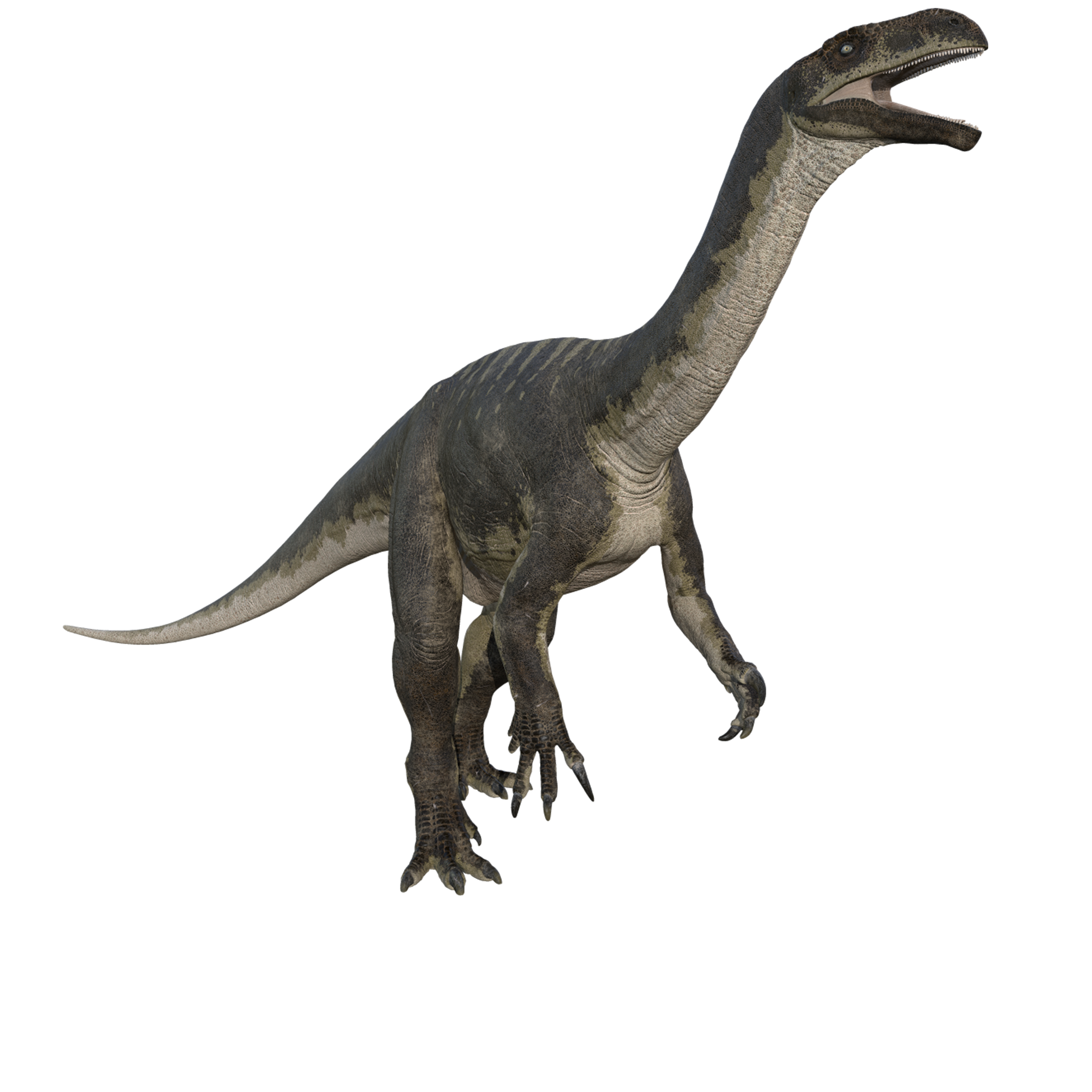The Swabian Dragon
Plateosaurus was the first "prosauropod" ever discovered, and it is now known from over 100 specimens, many from Swabia, Germany, earning it the nickname "Swabian Dragon", and making it one of the best-known Triassic dinosaurs!
Overview: Named in 1837, Plateosaurus was the first "prosauropod" ever discovered, and it was one of the first dinosaurs discovered in general. Initially too fragmentary and unrecognizable to be included in the definition of Dinosauria in 1842, it is now known from over 100 specimens, making it the best known "prosauropod" as well as one of the best-known Triassic dinosaurs. The high density of remains from Swabia, Germany earned it the nickname Schwäbischer Lindwurm, or the Swabian lindworm, lindorm being a word for a dragon in Germanic myths. This large bipedal herbivore was an early relative of the sauropods of the Jurassic and browsed on the floodplains of Late Triassic Germany and Switzerland.
Discovery: Plateosaurus was discovered in 1834 when German physician Johann Friedrich Engelhardt discovered some vertebrae and leg bones at Heroldsberg near Nuremberg, Germany. In 1837, these bones were described and named by German palaeontologist Hermann von Meyer, who named them Plateosaurus, which probably means “broad lizard”, though there is significant uncertainty about the intended meaning of the name. The initial specimen was very fragmentary, and when Sir Richard Owen coined the word “dinosaur” in 1842, Plateosaurus was not recognized as one, simply identified as a reptile. However, since then over 100 specimens have been collected in Germany, Switzerland, France, and Norway, making it not only the first discovered “prosauropod”, but also the best known, as well as one of the best-known Triassic dinosaurs.
Evolution: Plateosaurus was a basal sauropodomorph in the family Plateosauridae. Basal sauropodomorphs are often called “prosauropods” because they evolved before their close relatives, the true sauropods. They are not a true clade in the strict cladistic sense but form an evolutionary grade leading up to the clade Sauropoda. Plateosaurids are intermediate between basal “prosauropods” like Panphagia and Saturnalia, and more sauropod-like forms like Melanorosaurus or Lessemsaurus.
Description and Ecology: Plateosaurus was a bipedal animal, with study legs, short but powerful arms, a large stocky body (though it is “slender” compared to true sauropods), a long tail, long neck, and small head. It had a high degree of developmental plasticity, meaning there was a wide range of adult sizes it could achieve. It could grow 4.8-10 meters (16-33 ft) in length and weighed 600-4,000 kg (1,300-8,800 lbs). Its tail was very long, almost half its total length, and consisted of 40 vertebrae. It also had an elongated neck, but it still only had 10 cervical (neck) vertebrae, typical of most dinosaurs. Later sauropodomorphs would buck this trend and add additional neck vertebrae as their necks grew longer (for instance, Apatosaurus had 15 vertebrae in the neck and Mamenchisaurus had up to 19). Like most other dinosaurs, Plateosaurus was warm-blooded and had an avian-style respiratory system, though it had fewer and smaller pneumatic cavities in its bones than later sauropodomorphs. Plateosaurus had thick, serrated, leaf-shaped teeth which it used to crush vegetation. With its bipedal stance and long neck, it was probably a browser. Small juvenile Plateosaurus may have been prey for the large (by Triassic theropod standards) coelophysoid Liliensternus which grew 5.15 m (16.9 ft) long and was lightly built for chasing down prey smaller than itself. As such, it was probably unable to hunt Plateosaurus after a certain age, and adult Plateosaurus had no known likely predators.
Extinction and Legacy: Plateosaurus went extinct near the end of the Triassic Period, probably due to the End-Triassic Mass Extinction. However, while certain species were lost “prosauropods” and dinosaurs as a group were virtually unfazed by the extinction, which really only seemed to wipe out their competition. Prosauropods would continue into the Early Jurassic until being replaced by true sauropods by the Middle Jurassic. Plateosaurus can be found in various museums, including the Museum für Naturkunde in Berlin, Germany, the State Museum of Natural History Stuttgart in Stuttgart, Germany, the Sauriermuseum in Frick, Switzerland, the Museum of the Institute for Geosciences of the Eberhard-Karls-University in Tübingen, Germany (which has possibly the best and most accurate skeletal mount), the Royal Ontario Museum in Toronto, Ontario, Canada, the Museum of Ancient Life at Thanksgiving Point in Lehi, Utah, USA, and the American Museum of Natural History in New York City, New York, USA. Plateosaurus appeared in the dinosaur sequence in the 1940 Disney concert film Fantasia and in a brief sequence in the 1999 BBC documentary Walking with Dinosaurs (incorrectly portrayed as a quadruped). Most recently, it appeared in the 2023 Netflix documentary Life on Our Planet.
Plateosaurus FAQ
Plateosaurus size / How big was Plateosaurus?
See height, weight, and length.
Plateosaurus height / How tall was Plateosaurus?
Plateosaurus may have been around 2 meters (8.2 ft) tall in regular standing position but could likely have been taller when feeding by shifting to a more vertically oriented posture.
Plateosaurus weight / How much did a Plateosaurus weigh?
Plateosaurus probably weighed about 600-4,000 kg (1,300-8,800 lbs).
How long was Plateosaurus?
Plateosaurus grew 4.8-10 meters (16-33 ft) in length.
What did Plateosaurus eat?
Plateosaurus ate plants and may have been a browser of small trees.
What is Plateosaurus's closest living relative?
Like all dinosaurs, the closest relatives of Plateosaurus are the only surviving lineage of dinosaurs today, the birds. Crocodilians, while not dinosaurs themselves, are also more distant cousins of dinosaurs.
Plateosaurus family members / Plateosaurus family / What kind of dinosaur was Plateosaurus?
Plateosaurus was an early sauropodomorph (sauropods and their earlier relatives), or “prosauropod”, in the family Plateosauridae.
Where did Plateosaurus live? / Where was Plateosaurus found?
Plateosaurus lived in Europe and has been founds in Germany, Switzerland, France, and Norway!
When did Plateosaurus live?
Plateosaurus lived about 214-204 million years ago during the Late Triassic Period.
What does Plateosaurus mean? / Plateosaurus name meaning
Plateosaurus means “broad lizard”.

